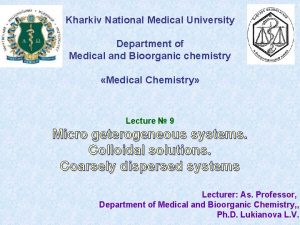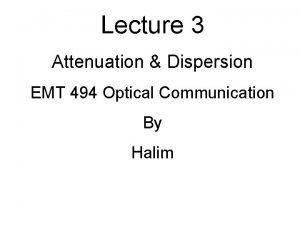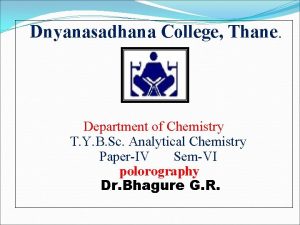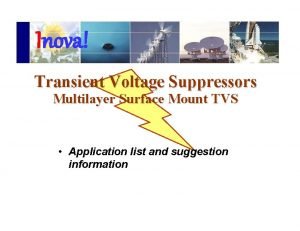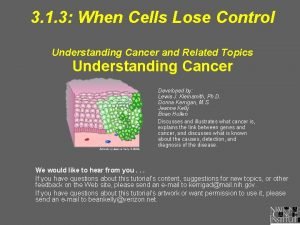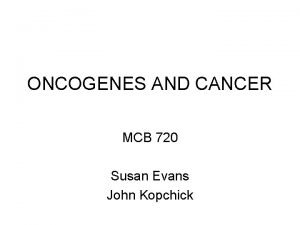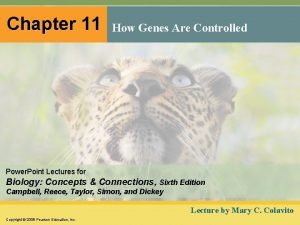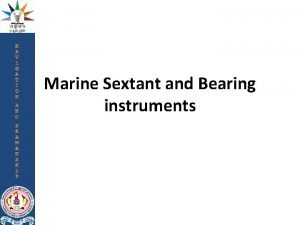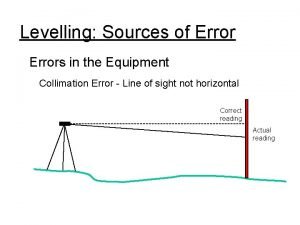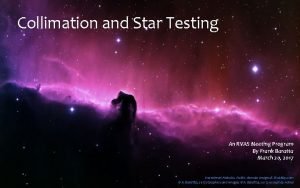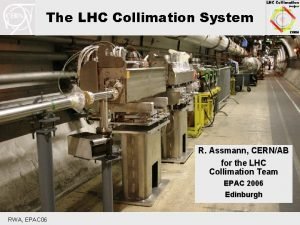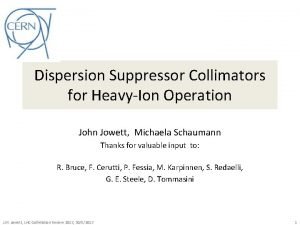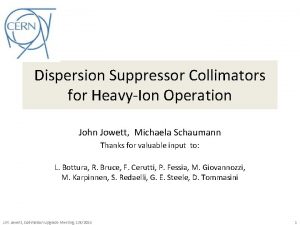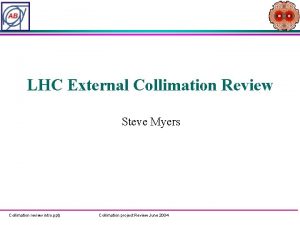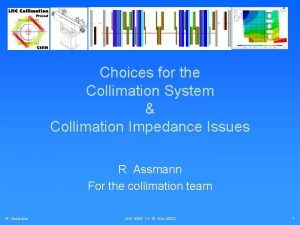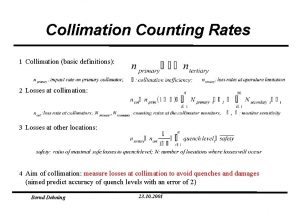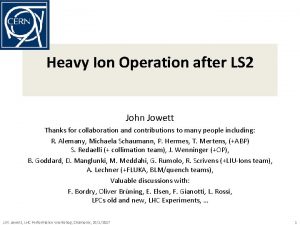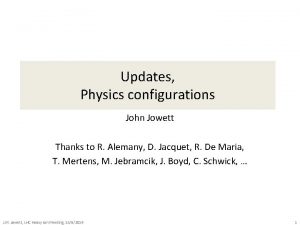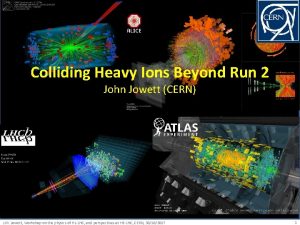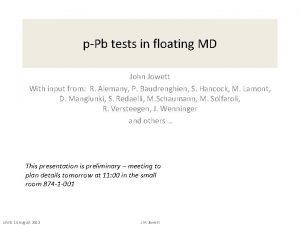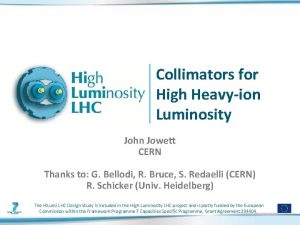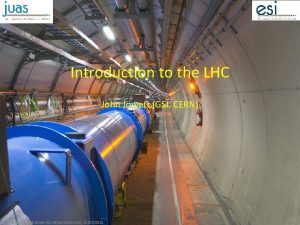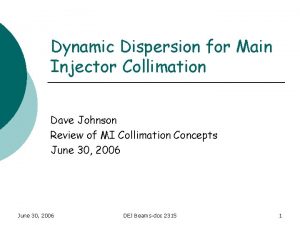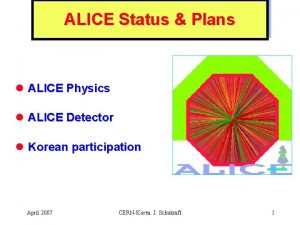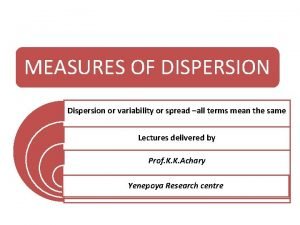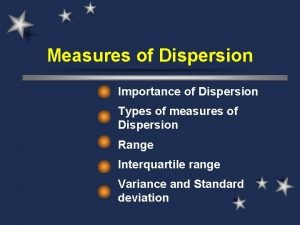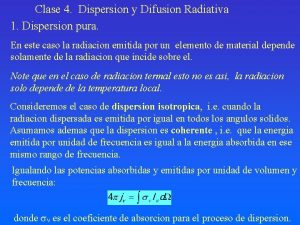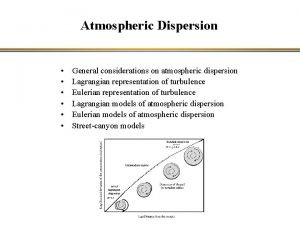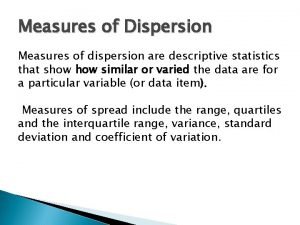Alternative Dispersion Suppressor Collimation for ALICE John Jowett





























- Slides: 29

Alternative Dispersion Suppressor Collimation for ALICE John Jowett With contributions from: M. Giovannozzi, T. Mertens, M. Schaumann For general background see previous presentations, in particular at COLUSM 1 August 2014 http: //indico. cern. ch/event/333525/ J. M. Jowett, Collimation Upgrade Meeting, 20/3/2015 1

Status of DS Collimation for LHC • Need for DS collimators emerged at Chamonix 2003 but too late to modify original design of cold DS regions • DS collimators may be needed, with varying degrees of likelihood/urgency, for: – – – Pb-Pb luminosity losses (BFPP, EMD, …) around ALICE Pb-Pb and p-Pb collimation losses in IR 7 and IR 3 p-p collimation losses in IR 7 and IR 3 Pb-Pb luminosity losses (BFPP, EMD, …) around ATLAS, CMS p-p luminosity debris around ATLAS, CMS at HL-LHC • Original solution (moving magnets to make space) dropped in favour of modular scheme, replacing standard MB dipole magnet with (2× 11 T dipoles+TCLD) unit, applicable in all potential locations. – Synergy with high-field magnet development. • Following 2013 Collimation Review: – First installation (2 TCLD units) foreseen for ALICE Pb-Pb in LS 2, subject to confirmation after 2015 Pb-Pb run and tests of bump mitigation techniques – Further installations elsewhere in LS 3, depending on experience at higher energy and luminosity, quench test results, etc J. M. Jowett, Collimation Upgrade Meeting, 20/3/2015 2

TCLD absorbs secondary beams from Pb-Pb collisions Can select addition beams by adjusting collimator gap Example of IR 2, deliver full luminosity after ALICE upgrade during LS, quenches likely J. M. Jowett, Collimation Upgrade Meeting, 20/3/2015 3

DS collimator installation in IR 2 Nominal Beam Line IP 2 Magnet to be replaced MB. A 10 R 2 Modified Sequence J. M. Jowett, Collimation Upgrade Meeting, 20/3/2015 4

DS Collimator locations around ATLAS (or CMS) Different from IR 2 because of QF/QD polarity in dispersion suppressor J. M. Jowett, Collimation Upgrade Meeting, 20/3/2015 5

Quench Mitigation with Orbit Bumps tested at CMS R. Bruce et al. , Beam losses from ultraperipheral nuclear collisions between 208 Pb 82+ ions in the Large Hadron Collider and their alleviation, Phys. Rev. ST Accel. Beams 12, 071002 (2009) Orbit bumps could be used to spread out and move the secondary beam losses to a less vulnerable location in order to reduce risk of quench. Will be operational in 2015 for all experiments. End-of-fill experiment on 24/11/2011 – Fill 2319. 3 -magnet orbit bump with peak amplitude of x = -2. 6 mm at MQ. 11 R 5. B 1 w/o bump with bump → Moves BFPP 1 beam impact position further downstream, increasing impact angle and spot size. J. M. Jowett, Collimation Upgrade Meeting, 20/3/2015 6

Observations during the Experiment Loss Evolution during Experiment Zoom to impact region no bump with bump BLM losses Losses were gradually reduced with increasing bump amplitude. At full bump amplitude, highest loss peak on a BLM was reduced by about a factor 10, while the dose on the next downstream BLM increased only by a factor 2. Fully analysed with FLUKA simulations. Discussed in more detail at 2013 Collimation Review, M. Schaumann thesis and LBOC 2 March 2015, https: //indico. cern. ch/event/368172/ J. M. Jowett, Collimation Upgrade Meeting, 20/3/2015 7

Alternative TCLD installation for IR 2 • Bump mitigation as in 2011 experiment is less effective in IR 2 than in IR 1/IR 5 – Some effect predicted in 2009 paper, could be marginally enough, depending on true quench limit, plan to test in 2015 – Hence IR 2 was given priority for possible TCLDs • Alternative proposed at Col. USM 1 August 2014 http: //indico. cern. ch/event/333525/ • Because of the form of the dispersion function in IR 2, there is a possibility that we can combine bumps and an alternative location of the TCLD in the connection cryostat (missing MB) – – No 11 T magnets required Different but apparently simpler integration Significant orbit bump during luminosity operation ! Option to include an additional horizontal corrector beside it. J. M. Jowett, Collimation Upgrade Meeting, 20/3/2015 8

TCLD in connection cryostat at IR 2 Variations of optics, bump and use of available orbit correctors studied (Tom Mertens, next talk). Solution only applicable in IR 2. J. M. Jowett, Collimation Upgrade Meeting, 20/3/2015 9

BFPP loss mitigation prospects - summary • Run 2: – ATLAS and CMS will have about twice design luminosity, some risk of quenches that we can mitigate with bump method (as long planned) – ALICE luminosity will be levelled design value, unlikely to cause quenches. Just as well, since the bump mitigation method will not work so well for ALICE. • Run 3 (after LS 2 upgrade of ALICE): – Good chance that bumps will still work for ATLAS/CMS. If not, we level, and consider installation DS collimators during LS 3. – Full luminosity in ALICE, likely to cause quenches, bumps unlikely to help much, use DS collimators installed during LS 2. J. M. Jowett, Collimation Upgrade Meeting, 20/3/2015 10

Conclusions - from LHC Heavy Ion point of view • Long-term goal of HL-LHC heavy ions: 10 nb-1 Pb-Pb plus various special runs (p-Pb, etc) – With all (few) presently planned LIU/HL-LHC heavy-ion luminosity upgrades we expect ~1. 2 nb-1/(1 month run) (see RLIUP workshop for details) – Confirms need for all upgrades during LS 2: to match ALICE upgrade and to approach goal in reasonable time • As foreseen at 2013 Collimation Review, we are now approaching the decision point for IR 2 DS collimator installation. – Are we being asked to decide earlier? • We continue to consider all our options for mitigation of losses from Pb-Pb luminosity. – Bumps will be used operationally in 2015. Quench tests vital. • The alternative TCLD installation proposed in Aug 2014 looks acceptable for ALICE (and only ALICE) – Insurance in case 11 T magnets are not available for LS 2 – Could also allow (11 T magnet+TCLD) units to be used elsewhere (IR 7? ) – Or could save costs • Needed: – Integration study for TCLD in connection cryostat J. M. Jowett, Collimation Upgrade Meeting, 20/3/2015 11

BACKUP SLIDES J. M. Jowett, Collimation Upgrade Meeting, 20/3/2015 12

Recommendations 1 • The committee strongly encourages the development and prototyping of a 11 T (5. 5 m) dipole magnet, and the cyrobypass/collimator unit. • Build at least 4 units (1 unit consists of 2 magnets + bypass + collimator) since this would cover 2 possible cases: – either 2 units in IR 2 for ion operation (and 2 spares), or – 4 units in IR 7 for proton operation • For LS 2 deployment serial «learning curves» of making coils at CERN and later in EU industries cannot be accomodated. The committee agrees with the early involvement of industrial partners. • Make full use of knowledge acquired in the Nb 3 Sn dipole and quadrupole programs to support each other. Committee Report from Collimation Review 2013

Recommendations 3 • Study alternative options to the DS collimators that provide a reduction of the energy deposition by about a factor of 2, possibly sufficient for operation with ions – Distributing the energy deposition in the magnet by using dynamic orbit bumps – Installation of a thicker beam screen compatible with the aperture inside the vacuum chamber Committee Report from Collimation Review 2013

Recommendations 4 • The quench tests that were performed demonstrate that it is essential to calibrate the complex theoretical models (using particle tacking, hadron shower codes and quench codes) with experimental data. • Complete the analysis of these tests with the objective of a coherent understanding of the quench limits as a function of loss duration. • Perform quench tests at high energy, e. g. 6. 5 Te. V, as soon as possible after the restart of LHC in 2015, including tests with ions. Committee Report from Collimation Review 2013

Steady-state losses during Pb-Pb Collisions in 2011 Bound-free pair production secondary beams from IPs IBS & Electromagnetic dissociation at IPs, taken up by momentum collimators Losses from collimation inefficiency, nuclear processes in primary collimators ? ? J. M. Jowett, Collimation Upgrade Meeting, 20/3/2015 16

Electromagnetic processes in Pb-Pb collisions Each of these makes a secondary beam emerging from the IP with rigidity change Discussed since Chamonix 2003 … Hadronic cross section is 8 b (so much less power in debris). J. M. Jowett, Collimation Upgrade Meeting, 20/3/2015 17

2011 Pb-Pb operation J. M. Jowett, Collimation Upgrade Meeting, 20/3/2015 18

Zoom in to loss region J. M. Jowett, Collimation Upgrade Meeting, 20/3/2015 19

Main losses in DS are due to luminosity Regular physics fill J. M. Jowett, Collimation Upgrade Meeting, 20/3/2015 From van der Meer scans 20

HL-LHC Performance Goals for Pb-Pb collisions With upgrade of Pb injectors, etc, indicative parameter goals: ATLAS and CMS also taking luminosity (high burn-off). Levelling strategies may reduce peak luminosity but we must aim for high intensity. Comparison data: p-Pb runs every few years are less demanding from beam-loss point of view Runs with lighter species (unlikely ? ) are not considered here. J. M. Jowett, Collimation Upgrade Meeting, 20/3/2015 21

Power density in superconducting cable FLUKA shower simulation See other talks! FLUKA studies confirmed recently (next talk). J. M. Jowett, Collimation Upgrade Meeting, 20/3/2015 Nevertheless, expect to quench MB and possibly MQ! 22

• • • BFPP mitigation by bumps Proposed in R. Bruce et al, Phys Rev STAB, 12, 071002 (2009) Apply bump to main beam orbit in loss region, also moves BFPP beam away from impact point, reducing flux, angle of incidence, peak power density. Tested opportunistically in 2011 Pb-Pb run gained on BLM signals. If truly effective and reliable, and accepted by Machine Protection, could be an alternative to DS collimators. May have to rely on this in the period after LS 1. J. M. Jowett, Collimation Upgrade Meeting, 20/3/2015 23

Orbit bump: -2. 6 mm at Q 11. R 5. B 1 in steps 12 sigma envelopes from online model without bump with bump J. M. Jowett, Collimation Upgrade Meeting, 20/3/2015 24

Effect on losses No losses or lifetime drops J. M. Jowett, Collimation Upgrade Meeting, 20/3/2015 25

Effect on loss pattern Before Bump -2. 6 mm Not enough to create 2 nd loss peak J. M. Jowett, Collimation Upgrade Meeting, 20/3/2015 26

Example of 206 Pb created by EMD 2 in primary collimator • Green rays are ions that almost reach collimator • Blue rays are 206 Pb rays with rigidity change Beam pipe in IR 7 of LHC “Obvious” solution is to put more collimators here. Primary collimator J. M. Jowett, Collimation Upgrade Meeting, 20/3/2015 27

DS collimators in IR 7 for heavy ions • No quench test with ion beams in 2013 • Some results from 2011 only showed that upgraded design intensity is just OK with 1 h lifetimes (questionable? ). • In 2013 p-Pb run, we were forced to raise BLM thresholds to nominal quench limit in squeeze because of losses – Pb beams are larger than p beams – Partly related to movements of orbit, tight collimators • Experience after LS 1 essential to allow better evaluation of need for DS collimators in IR 7. Need to watch this! • DS collimators very effective for Pb in IR 7 (see simulations by G. Bellodi in 2011 Collimation Review). J. M. Jowett, Collimation Upgrade Meeting, 20/3/2015 28

Bump method to mitigate losses in IR 7 (test in 2013) • Test of B 1 horizontal orbit bump in IP 7 around Q 11. R 7 (+2. 5 mm), to spread the losses longitudinally, • It worked, we observe a factor 1. 62 ± 0. 04 gain on the maximum loss peak, • But losses were reduced at the primary collimator, which should not be influenced, → was there an orbit non closure propagating through the ring? without with R. Bruce, E. B. Holzer, J. Jowett, S. Redaelli, B. Salvachua, M. Schaumann Bump TCP. A 6 L 7. B 1 OFF Bump ON J. M. Jowett, Collimation Upgrade Meeting, 20/3/2015 Bump OFF Bump ON 29
 Dispersion phase and dispersion medium
Dispersion phase and dispersion medium Lyophilic colloids and lyophobic colloids difference
Lyophilic colloids and lyophobic colloids difference Material dispersion
Material dispersion Xxnx ty
Xxnx ty Surface mount transient voltage suppressor
Surface mount transient voltage suppressor Tumor suppressor genes
Tumor suppressor genes Tumor suppressor genes
Tumor suppressor genes Oncogenes and tumor suppressor genes
Oncogenes and tumor suppressor genes Tumor suppressor gene
Tumor suppressor gene Non adjustable errors of sextant
Non adjustable errors of sextant Collimation error
Collimation error Star testing telescope
Star testing telescope And a modular collimation system
And a modular collimation system Kontinuitetshantering
Kontinuitetshantering Novell typiska drag
Novell typiska drag Nationell inriktning för artificiell intelligens
Nationell inriktning för artificiell intelligens Returpilarna
Returpilarna Shingelfrisyren
Shingelfrisyren En lathund för arbete med kontinuitetshantering
En lathund för arbete med kontinuitetshantering Underlag för särskild löneskatt på pensionskostnader
Underlag för särskild löneskatt på pensionskostnader Tidbok
Tidbok A gastrica
A gastrica Förklara densitet för barn
Förklara densitet för barn Datorkunskap för nybörjare
Datorkunskap för nybörjare Tack för att ni lyssnade bild
Tack för att ni lyssnade bild Att skriva en debattartikel
Att skriva en debattartikel Autokratiskt ledarskap
Autokratiskt ledarskap Nyckelkompetenser för livslångt lärande
Nyckelkompetenser för livslångt lärande Påbyggnader för flakfordon
Påbyggnader för flakfordon Formel för lufttryck
Formel för lufttryck
